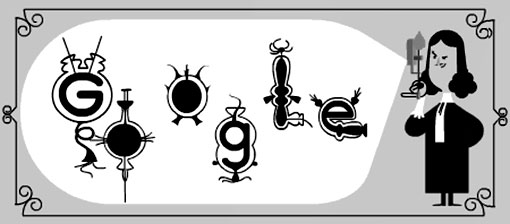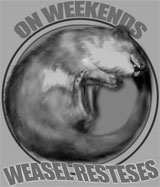We will not forget you, Space Bat

Eight years ago today, at a launch of the space shuttle Discovery, a little brown bat flew onto the shuttle’s fuel tank during countdown and hung on for all he was worth. Experts who analyzed the footage afterwards (bat experts, natch) think he had a broken wing and dislocated shoulder or wrist.
Wrist. On a bat. Flying mammals are confusing.
They thought surely he would drop off, but he didn’t. Periodically, he shifted position, but hung on for as long as the shuttle was in sight. He died quickly in the cold and airless upper atmosphere. Or incinerated. Probably. But what a sendoff!
Space Bat, you will live forever in our hearts.
March 15, 2017 — 9:48 pm
Comments: 14
Brit found dead at Spanish airport had ‘slice of ham on each buttock and his genitals in tuna can’

Yes, it’s a real headline. No, I have no idea. Nobody has.
Now that I have your attention, I’d like to talk about something else. Today’s Google doodle celebrates the 384th birthday of Anton von Leeuwenhoek. Unlike most Google doodles that promote obscure scientists I never heard of, von Leeuwenhoek is an obscure scientist who is a great hero of mine.
Because microscopes. Von Leeuwenhoek was the first great miscroscopist and one of the greatest ever amateur scientists (I used to be big time into microscopy. And amateurishness). He was a Dutchman who owned a draper’s shop and later worked a series of civil service jobs. Microscopes were a hobby.
But he made fantastic microscopes that no-one of his era could match. Hundreds of them using a process he refused to divulge. Everyone else was grinding and polishing bits of glass for hours and assumed he did, too. In fact (I’ve forgotten where I read this, I’ve read so much about him over the years) he dripped molten glass into water, which formed optically perfect spheres with no mechanical finishing at all. Genius.
He was the first human being to see lots of neat things: protozoa. Bacteria. Tooth plaque. Sperm. Yeah, he got those last two samples exactly the way you think he did.
In 1926, a man named Paul de Kruif (an American of Dutch ancestry) wrote a book called the Microbe Hunters that has never since gone out of print. It takes microbiology from von Leeuwenhoek to Paul Ehrlich. It was a breathlessly enthusiastic not at all nuanced ‘Hooray for Science!’ book of the kind that inspired thousands of young scientists, and that educators can’t abide these days.
I loved it. Buy it for a kid.
Shame about that poor bastard in the Spanish airport, though, huh?
October 24, 2016 — 7:02 pm
Comments: 19
Happy Equinox! It just gets darker and colder from here!

There. I’m out of my nightly lavender-and-eucalyptus soak and feeling somewhat less like The Dearly Departed.
Classic FM played three interesting songs while I was in the bath. In 1875, a St Petersburg music magazine commissioned Tchaikovsky to write twelve little piano pieces, one for each month of the year, then published one each month to their readership.
That’s right. Tchaikovsky was once a magazine giveaway, like spoons or model train bits or Franklin Collectibles.
Nothing new under the sun. Except the part about Tchaikovsky.
September 22, 2016 — 9:43 pm
Comments: 5
Okay, hear me out…

Tonight we went to a talk on crop circles. I wasn’t all that hot to go — not really my thing — but we promised friends.
Hoo boy, was it interesting. I wasn’t convinced by any particular theory (he wasn’t pushing any particular theory). He showed us dozens of photographs (out of, apparently, ten thousand known circles) and several things are factually indisputable:
■ There are still hundreds of them appearing every year, mostly across Europe.
■ The most complex ones are made stunningly fast, sometimes right by a busy road, without anyone being spotted nearby.
■ And holy shit have they gotten elaborate! Seriously, look at this Google Image search.
Some are definitely man-made, but the ones that people have taken credit for making are, in a word, pretty lame. They take a long time to make, are pretty simple and look kind of wonky. None of the perfect circles and long, straight lines.
Nobody has stepped forward to claim any of the really amazing ones, and nobody who makes them can figure out how the amazing ones were done. They are HUGE and complex and precise and amazing. The one in the picture at the top has a sort of wheaten basket weave, for example.
Now, when you get to the one that show a giant dot-matrix portrait of a typical X-Files gray holding a disk with legible digital message in ASCII English, you feel sure somebody’s pulling your leg. But that’s just it — how the fuck are they doing it?
May 12, 2016 — 10:09 pm
Comments: 22
Weasels versus Science!

I hope you read that in a 1950’s B-movie narrator voice, kthx. Weasels won, obviously.
A small animal has brought down the Large Hadron Collider; the perp has been positively identified as a weasel. I’m not sure how. Burnt weasel, probably.
CERN shut the big beast down due to “technical issues in the last 24 hours, including a power cut (likely due to the passage of a small wild animal on a 66 kV/18kV electrical transformer.)”
“Passage” I assume in the sense of “passed away.” Pining for the fjords. Joining the choir eternal. An ex-weasel.
Still good going. Particularly when you remember what they call weasels over here are what you call least weasels over there. The itty-bitty dudes. (Link sent to me by multiple people — interestingly, from a different newspaper source each time — and I enjoyed it more each and every time).
Now, my imaginary internet friends, I have given you short shrift this week, on account of I am taking next week off and I brought a metric crap-ton of work home to prepare. The old hands among you will recall that I have a birfday in early May. I shall post sweet nothings for the week, I think.
Have a good Weasel’s birthday week, everyone!
April 29, 2016 — 8:07 pm
Comments: 14
Words.

Okay, so scientists took seven people and hooked them up to a brainal probe while they listened to a radio program (The Moth, in case you’re wondering). Then they mapped the “50,000 to 80,000 pea-sized spots all over the cerebral cortex” that lit up for each word the subjects heard.
I had no idea words were processed all over the brain…did you? Surely, speech itself is more localized, or people who’ve suffered a stroke would lose vocabulary words, not speech generally.
Secondly, the words mapped to similar locations for all seven people. On the top right side of the brain live all the words for family members. On the left, just over the ear, are words for crime and justice. Words with multiple meanings light up multiple places.
There’s an interactive map, but I couldn’t get it to work. I’ve got a lot of applications open, the website made my hard disk graunch and chunder to little effect, so I think it’s an intensive app.
Now, it was just seven people, they were all English speakers of a certain level of accomplishment, and this is the first study of its kind, so…all very preliminary. But very interesting, nonetheless.
I’ll tell you this right now: the part of my brain that processes names is as smooth as a baby’s butt.
Thanks to commenter Can’t Hark My Cry for the link.
April 28, 2016 — 9:26 pm
Comments: 12
You’re welcome

Yeah, it’s getting increasingly hard to find things to say that aren’t the election or the EU referendum. I’d’ve given you a cat picture instead, but I was too lazy to camera.
February 24, 2016 — 10:32 pm
Comments: 24
Wherein Weasel channels Mr Wizard

Refractive index is a measure of how much light is bent — or, to put it another way, slowed down — by a transparent or translucent material. Light moves through water 1.33 times slower than it does through a vacuum, so the refractive index of water is 1.33.
Oh, half y’all are physics geeks. You know this. I only know it because when I was a kid I thought I could invent an iridescent surface by combining painting materials with greatly different refractive indices. A thin layer of something on top of a thick layer of something with a very different RI will make a rainbow. Soap bubbles. Motor oil in a water puddle.
I failed, but let’s not dwell on that.
All this is by way of introduction to this cool video I ran across this evening. Because they have identical refractive indices, this is what happens when you dip a borosilicate rod (i.e. what Pyrex used to be before they changed the formula) into a beaker of cooking oil or glycerin.
I feel terribly, terribly cheated that real scientists don’t sit around doing this kind of shit all day.
February 1, 2016 — 10:12 pm
Comments: 18
Well, there’s always 2025

A bunch of us, strangers, gathered on a scenic overlook facing East at 9:35 and saw a deep and impenetrable nothingburger. We weren’t even able to figure out exactly where the sun was. After a while, someone muttered, “looks like your typical gray English morning.”
Other parts of the country were luckier.
In addition to the eclipse, y’all know it’s the Equinox, yes? So it was also the day blue hairs descend on Stonehenge for the world’s most elderly cosplay competition.
Good weekend, all!
March 20, 2015 — 10:49 pm
Comments: 18
What weasels is made of

So, my DNA is winging its way to a lab in the Netherlands (I think) even as we speak. It was inevitable, once I got interested in the DNA of the local population, that I would start wondering what was in my own. BTW, dredging up 1cc of spit is surprisingly hard to do. Bubbles don’t count!
I looked around at different services and decided 23andMe suited me best. They report on ancestry (i.e. ethnicity) but also genetic risk factors, inherited conditions, some genetic traits and drug responses. I understand some people really, really don’t want to know those last few things, and for them there’s ancestry (the DNA testing service of ancestry.com) which only does ethnicity.
It’s worth having a poke around and see what they can find in your genes these days. Eye color, birth weight, baldness. Yeah, I know you know all those things about yourself, but knowing we can identify the genes means we can tell so much more about the people whose bones we dig up. Or the people who commit crimes and are careless enough to leave DNA behind.
Even more interesting, in a way, is what they can’t tell: they can’t measure Jewish or Native American ancestry. Well, they can trace Ashkenazi Jews, but not Middle Eastern lines, which are just semitic. And American Indians show up as generic Far Eastern (and ha! ha! to the indigenous campaigners who denied this obvious fact).
My family’s been in the States a long, long time, so I’m not going to be a purebred anything. This post represents my pledge to you: if something distinctly unWASPy shakes out of my family tree — say, a gypsy or hottentot — I will freely confess. And then I’ll start applying for all that sweet, sweet government aid to minorities.
Good weekend!
March 6, 2015 — 9:51 pm
Comments: 22











